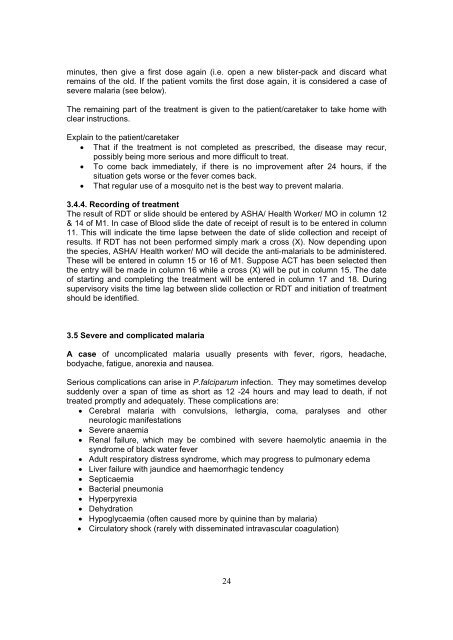Training Module for Medical Officer - NVBDCP
Training Module for Medical Officer - NVBDCP
Training Module for Medical Officer - NVBDCP
Create successful ePaper yourself
Turn your PDF publications into a flip-book with our unique Google optimized e-Paper software.
minutes, then give a first dose again (i.e. open a new blister-pack and discard whatremains of the old. If the patient vomits the first dose again, it is considered a case ofsevere malaria (see below).The remaining part of the treatment is given to the patient/caretaker to take home withclear instructions.Explain to the patient/caretaker That if the treatment is not completed as prescribed, the disease may recur,possibly being more serious and more difficult to treat. To come back immediately, if there is no improvement after 24 hours, if thesituation gets worse or the fever comes back. That regular use of a mosquito net is the best way to prevent malaria.3.4.4. Recording of treatmentThe result of RDT or slide should be entered by ASHA/ Health Worker/ MO in column 12& 14 of M1. In case of Blood slide the date of receipt of result is to be entered in column11. This will indicate the time lapse between the date of slide collection and receipt ofresults. If RDT has not been per<strong>for</strong>med simply mark a cross (X). Now depending uponthe species, ASHA/ Health worker/ MO will decide the anti-malarials to be administered.These will be entered in column 15 or 16 of M1. Suppose ACT has been selected thenthe entry will be made in column 16 while a cross (X) will be put in column 15. The dateof starting and completing the treatment will be entered in column 17 and 18. Duringsupervisory visits the time lag between slide collection or RDT and initiation of treatmentshould be identified.3.5 Severe and complicated malariaA case of uncomplicated malaria usually presents with fever, rigors, headache,bodyache, fatigue, anorexia and nausea.Serious complications can arise in P.falciparum infection. They may sometimes developsuddenly over a span of time as short as 12 -24 hours and may lead to death, if nottreated promptly and adequately. These complications are: Cerebral malaria with convulsions, lethargia, coma, paralyses and otherneurologic manifestations Severe anaemia Renal failure, which may be combined with severe haemolytic anaemia in thesyndrome of black water fever Adult respiratory distress syndrome, which may progress to pulmonary edema Liver failure with jaundice and haemorrhagic tendency Septicaemia Bacterial pneumonia Hyperpyrexia Dehydration Hypoglycaemia (often caused more by quinine than by malaria) Circulatory shock (rarely with disseminated intravascular coagulation)24
















